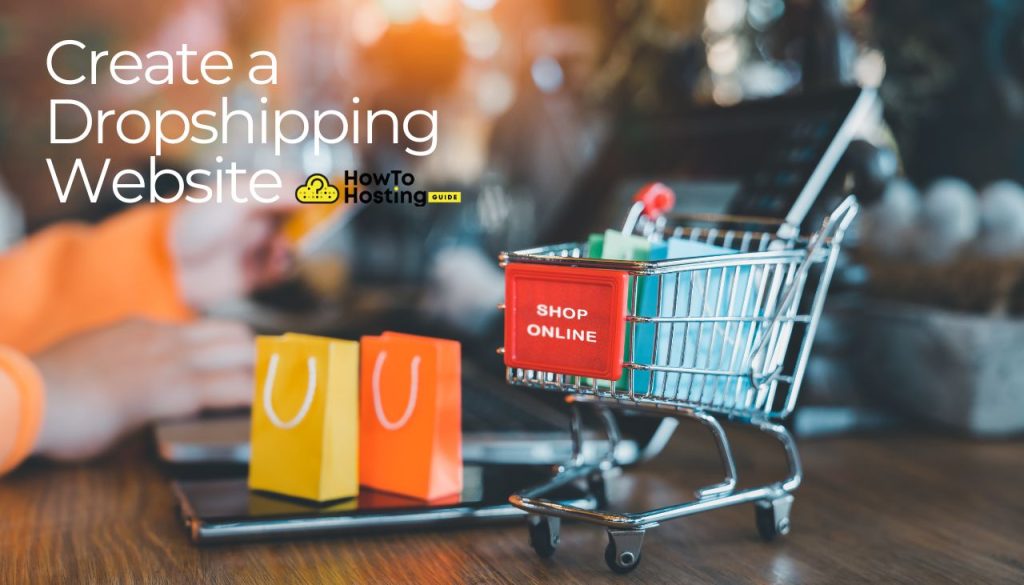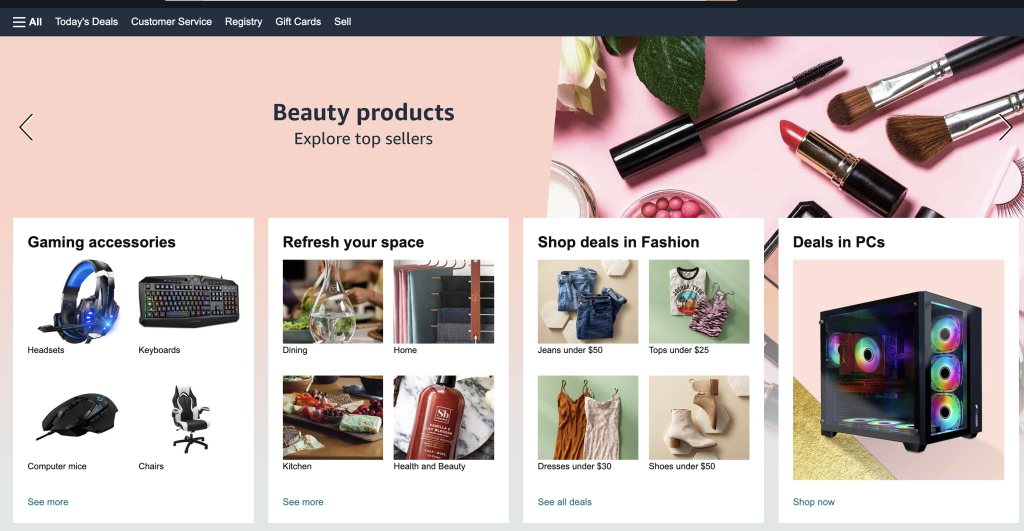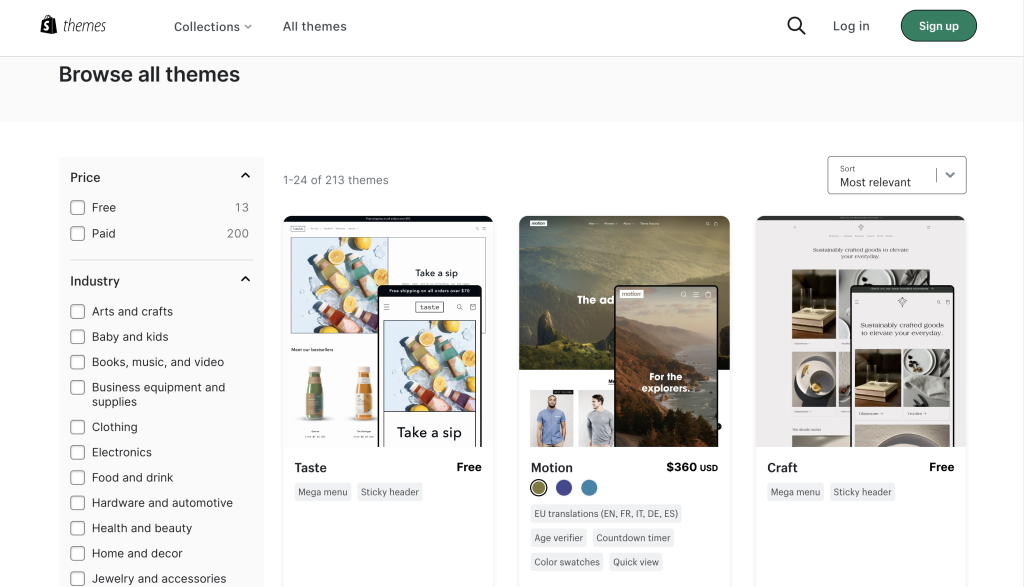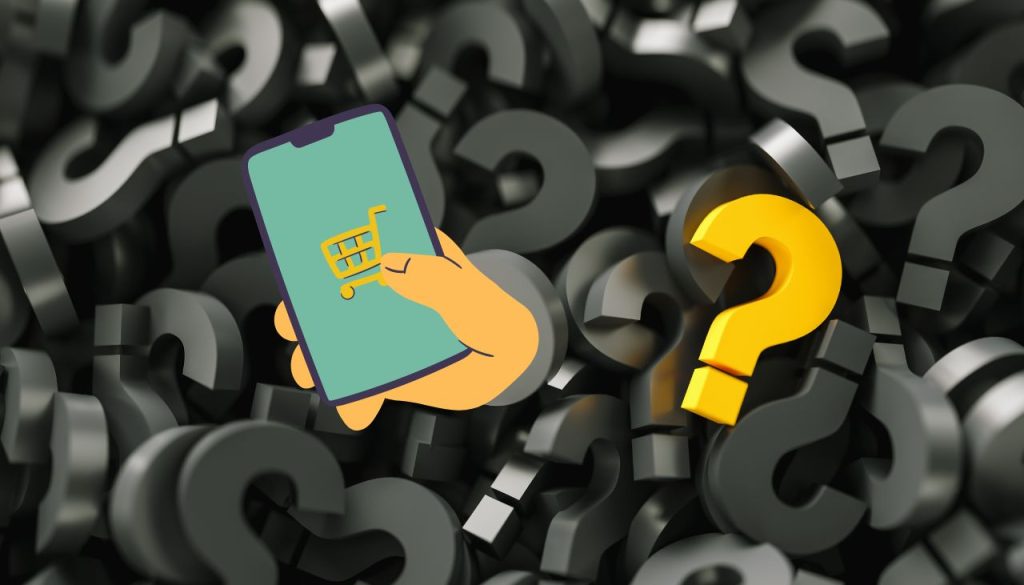On This Page: [hide]
Looking to venture into the world of e-commerce without the headache of inventory and shipment management? Shopify emerges as the leading platform for dropshipping entrepreneurs, offering a seamless, user-friendly experience packed with essential tools for starting, operating, and growing an online business.
Read on to discover how Shopify’s flexibility, scalability, and comprehensive features can set the stage for your dropshipping success, whether you’re just starting out or aiming to expand your digital empire.

What is Dropshipping?
Dropshipping is a popular business model that allows entrepreneurs to run an online store
without the need to stock products or manage inventory. In a dropshipping business, you act as the intermediary
between the customer and a third-party supplier. When a customer places an order on your store, the details are sent
directly to your dropshipping supplier, who then ships the product straight to the customer’s doorstep.
This means you never have to handle products yourself or worry about inventory management.
The dropshipping model is attractive because it significantly reduces upfront costs.
You don’t need to invest in large quantities of stock or rent warehouse space, making it a low-risk
way to start an online business.
Instead, you can focus on:
- Marketing your store
- Building your brand
- Providing excellent customer service
By leveraging dropshipping, entrepreneurs can quickly launch an online store, test new products,
and adapt to market trends without the financial burden of traditional retail.
Choosing the Best Dropshipping Website Builder
Selecting the best dropshipping website builder is a crucial step in creating a successful dropshipping business.
The right platform will make it easy to design, launch, and manage your online store, while also integrating seamlessly with
dropshipping suppliers.
When evaluating dropshipping website builders, consider:
- User-friendliness
- Customization options
- Pricing
- Quality of customer support
Popular dropshipping website builders such as Shopify, Wix, and SellShop
are designed with entrepreneurs in mind. They offer:
- Intuitive drag-and-drop interfaces
- A wide range of professional templates
- Built-in tools for connecting with dropshipping suppliers
These platforms also provide features to help you attract customers, such as:
- SEO optimization
- Marketing integrations
- Analytics dashboards
By choosing a dropshipping website builder that fits your needs, you can focus on
growing your business and reaching your target audience,
rather than getting bogged down by technical challenges.
Why Shopify Is the Top Choice for Dropshipping Entrepreneurs
Shopify stands out as the preferred platform for dropshipping entrepreneurs for several reasons.
Its user-friendly interface, combined with a wide range of features tailored specifically for
dropshipping, makes it an attractive choice for both new and experienced e-commerce business owners.
Shopify allows seamless integration with various dropshipping platforms, making it easier to:
- Find reliable suppliers
- Manage orders efficiently
The Shopify ecosystem offers the perfect balance of simplicity and power, providing the tools needed to:
- Start a dropshipping business
- Manage and fulfill orders
- Grow and scale operations
This accessibility is crucial for entrepreneurs seeking to enter the market quickly,
without requiring extensive technical skills or large upfront investments.
For those ready to dive into e-commerce, Shopify makes it possible to
launch and manage a professional dropshipping website quickly,
streamlining the journey to building a profitable online store.
Why Shopify Is the Top Choice for Dropshipping Entrepreneurs
Shopify stands out as the preferred platform for dropshipping entrepreneurs for several reasons. Its user-friendly nature, combined with a wide array of features specifically designed for dropshipping, makes it an attractive choice for new and seasoned e-commerce business owners alike.
Shopify’s ecosystem offers a perfect blend of simplicity and power, providing the tools needed to start, manage, and grow a dropshipping business with ease. This accessibility is critical for those looking to swiftly enter the market without the need for extensive technical knowledge or significant upfront investment.
From Flexibility to Scalability: The Shopify Advantage
One of the most compelling advantages of using Shopify for dropshipping is its incredible flexibility. Entrepreneurs can select from a vast selection of products to sell, thanks to Shopify’s integration with various dropshipping suppliers and apps. This flexibility extends to the customization of your online store, enabling you to create a unique shopping experience that reflects your brand.
Furthermore, Shopify’s scalability is a game-changer for growing businesses. As your dropshipping business expands, Shopify can effortlessly accommodate the increased inventory, more sophisticated marketing strategies, and higher traffic volumes without skipping a beat. This scalability means that entrepreneurs can start small and grow their business at their own pace, without having to migrate to another platform.
How Shopify Simplifies the Dropshipping Model
Shopify simplifies the dropshipping model by streamlining the process of setting up and running an e-commerce store. The platform removes the need to deal with the complexities of inventory management and direct shipping.

With Shopify, once a customer places an order, the details are automatically forwarded to your dropshipping partner who then handles the fulfillment process. This automated workflow significantly reduces the manual effort required to operate a store and allows business owners to focus more on customer service and marketing.
In addition, Shopify provides a suite of tools designed to optimize your store for sales. From customizable themes that don’t require coding knowledge to create an appealing storefront, to integrated SEO features that help your store rank higher in search results, the platform is equipped to help entrepreneurs attract and retain customers. Furthermore, Shopify’s analytics tools offer insights into customer behavior and sales trends, enabling data-driven decisions that can propel a business forward.
Ultimately, Shopify embodies the ideal e-commerce platform for dropshipping businesses by offering an easy-to-use, flexible, and scalable solution. It provides the foundation for success in the highly competitive online marketplace, without the need for a large initial investment or deep technical expertise. For entrepreneurs ready to dive into the e-commerce world, Shopify offers the tools and resources needed to turn their vision into a reality.
First Steps to Take When Starting a Dropshipping Business on Shopify
Entering the Shopify dropshipping arena is an exciting venture for aspiring entrepreneurs.
It is simple and accessible to start, making it an attractive option
for those looking to launch an online business.
The initial steps set the foundation for a successful online business.
By focusing on essential elements such as:
- Selecting a niche
- Finding reliable suppliers
- Setting up your Shopify store
You can lay a solid groundwork for your business’s growth.
Careful planning and preparation are crucial when starting a dropshipping business
to ensure long-term success.
Why Choosing the Right Niche Matters More Than You Think
Choosing a niche is critical in the crowded online marketplace. A well-defined niche helps in creating a focused marketing strategy, enabling you to connect with your target audience more effectively. It also simplifies the product selection process and enhances your brand’s identity, making it easier for customers to remember and trust your business.
How to Identify Profitable Dropshipping Niches in 2024
To find a niche that promises profitability, start by examining your passions and areas of expertise. When your interests align with your business, it infuses your work with genuine enthusiasm, which customers can sense. Next, employ tools like Google Trends to monitor the demand for potential niche products.
Examining the best-selling items on platforms like Amazon can also offer insights into stable or growing niche markets. Furthermore, analyzing market sizes, growth trends, and customer behavior provides valuable information on the viability of a niche. By carefully researching and choosing a niche, you significantly increase your chances of success.

Locating Suppliers: A Step-By-Step Process
Finding the right suppliers is a pivotal step in the dropshipping business model. Your supplier’s reliability and product quality directly impact your brand’s reputation and customer satisfaction.
Using Shopify’s Integrated Supplier Directory
Shopify offers an integrated supplier directory that makes finding reputable suppliers straightforward. This directory features a curated list of suppliers known for their reliability and quality products. By opting for suppliers from Shopify’s directory, you can ensure a smooth integration with your online store, facilitating easier product imports and order fulfillment.
Partnering with Reliable Suppliers Outside of Shopify
Broadening your search beyond Shopify’s directory can uncover unique products and competitive pricing, offering your store an edge in the market. Start by attending industry trade shows and networking events to meet potential suppliers in person. Online supplier databases and B2B marketplaces are also excellent resources for finding reputable suppliers worldwide. Prioritize suppliers with positive reviews and those willing to provide product samples for quality assessment.
Setting Up Your Shopify Store: A Beginner’s Guide
Your Shopify store is your brand’s online home. A well-designed store not only attracts visitors but also converts them into customers.
Selecting the Right Theme for Your Dropshipping Store
Choosing the right theme is crucial in creating a visually appealing storefront.

Shopify’s theme store offers a variety of options that cater to different industries and aesthetics. Look for a theme that aligns with your brand identity and offers a user-friendly experience. Ensure the theme is responsive, meaning it adjusts seamlessly across desktop and mobile devices.
Customizing Your Store for Maximum Conversion
Customizing your store goes beyond aesthetics. It involves optimizing various elements for enhanced user experience and conversion. Start by ensuring your site’s navigation is intuitive, making it easy for customers to find products. High-quality product images and detailed descriptions also play a significant role in influencing purchase decisions. Also, incorporating customer reviews and trust signals, like security badges, can significantly boost customer confidence. Attention to these details can turn your Shopify store into a powerful sales engine.
In conclusion, starting a dropshipping business on Shopify involves several crucial steps, each contributing to your store’s potential for success. By choosing the right niche, finding reliable suppliers, and setting up an optimized and visually appealing store, you can create a strong foundation for your dropshipping venture.
Optimizing Product Pages for Higher Conversions
For any dropshipping business, well-optimized product pages are essential for
converting visitors into paying customers and driving business growth.
A successful product page does more than just display an item—it builds trust,
answers questions, and encourages action.
- Use high-quality product images that showcase items from multiple angles.
- Write detailed, benefit-focused descriptions that address customer needs.
- Incorporate customer reviews and ratings to boost credibility.
- Use attention-grabbing headlines and highlight unique selling points.
- Implement competitive pricing and clear calls-to-action.
Don’t forget to optimize product pages for search engines by:
- Including relevant keywords
- Adding descriptive alt text for images
- Using structured data to enhance SEO
These strategies improve search engine rankings and attract organic traffic to your dropshipping site.
By continually refining product pages, you’ll create a seamless shopping experience
that keeps customers returning and supports long-term business growth.
Starting a Dropshipping Business with Limited Funds
Launching a dropshipping business doesn’t require a large investment, making it an
ideal option for entrepreneurs with limited funds.
To get started:
- Research profitable niches.
- Partner with reliable suppliers offering quality products and dependable shipping.
- Use free or low-cost website builders and marketing tools to create a professional store.
Building a strong brand identity is key to standing out in a competitive market. This includes:
- Designing a memorable logo
- Crafting a compelling brand story
- Providing excellent customer service to foster trust and loyalty
Optimize your product pages for higher conversions by:
- Using persuasive copy
- Displaying attractive product images
- Adding clear calls-to-action
Leverage social media and other free marketing channels to reach your target audience
and drive traffic to your store. By keeping upfront costs low and focusing on gradual, sustainable growth,
you can build a successful dropshipping business from the ground up—even on a tight budget.
Legal Considerations Before Launching Your Shopify Dropshipping Store
Before diving into the world of Shopify dropshipping, understanding the legal groundwork is crucial.
When setting up your dropshipping business, you must choose from common business structures
to ensure legal compliance and build credibility.
This guide highlights the essential steps to creating a legally sound foundation for your store, helping you:
- Comply with local and international regulations
- Protect your business and customers
- Avoid unnecessary legal complications
By taking the time to establish your business on a solid legal footing, you ensure that your Shopify dropshipping venture
starts on the right foot and is prepared for long-term success.
Choosing a Business Structure: LLC, Sole Proprietor, or Corporation?
Deciding on the structure of your business is a pivotal first step. Each option has its own set of benefits and legal implications. A Sole Proprietorship is straightforward to set up, with fewer initial costs and less paperwork; however, your personal assets are not protected if your business incurs debt or legal issues. An LLC, or Limited Liability Company, offers personal asset protection and suitable tax options, making it a popular choice among dropshippers. On the other hand, a Corporation provides the utmost asset protection and is a wise choice for those planning substantial growth, yet it comes with more complex requirements and paperwork.
Here’s a quick breakdown:
- Sole Proprietorship: Simple, less paperwork, but personal assets are at risk.
- LLC: Protects personal assets, offers tax benefits, but with more regulations.
- Corporation: Maximum asset protection, suitable for growth, but most complex.
Choosing the right structure will lay a solid foundation for your business and influence your financial and legal strategy in the long run.
The Importance of a Tax ID and Business License
To legally operate your Shopify dropshipping store, acquiring the necessary licenses and tax IDs is essential. Depending on your location, this might include a business license, a sales tax ID, and possibly more. In the U.S., for instance, a sales tax ID allows you to collect sales tax on sales, while an Employer Identification Number (EIN) enables you to hire employees and open a business bank account.
Here’s why securing these is crucial:
- A Tax ID legitimizes your business for tax collection and reporting purposes.
- A Business License ensures your operation is recognized by the local government, opening doors to various business resources and legal protections.
Remember, requirements vary by country and state, so consulting with a legal expert in your area can offer guidance tailored to your specific situation.
In conclusion, laying the legal groundwork for your Shopify dropshipping store is not a step to be overlooked. Choosing the appropriate business structure and securing the necessary tax ID and business licenses are foundational actions that protect your business and prepare it for success. By addressing these legal essentials from the outset, you’ll be better prepared to focus on growing your store and navigating the exciting path ahead.
Managing Finances for Your Shopify Dropshipping Business
Successfully managing your finances is crucial when running a Shopify dropshipping business. Creating a clear financial structure allows for better decision-making and can significantly impact the growth and sustainability of your online enterprise. This guide covers the essential financial setups, such as establishing a business bank account, understanding sales tax implications, and utilizing accounting software to keep your business finances in check.
Setting Up a Dedicated Business Bank Account
One of the first steps in solid financial management for your dropshipping business is to open a dedicated business bank account. This account should be used exclusively for business transactions, including receiving payments from customers and paying suppliers. Separating personal and business finances simplifies accounting practices and maintains clear financial records, which is beneficial for both daily management and long-term financial planning.
- Choose a bank: Research and choose a bank that offers business accounts with benefits that match your business needs, such as low fees, easy online access, and good customer service.
- Required documents: Prepare the necessary documentation, typically including your business license, registration details, and identification, to open your account.
- Understand the features: Familiarize yourself with the features your business account offers, such as transaction limits, fees, and online banking capabilities, to ensure it aligns with your business operations.
Understanding Sales Tax and Dropshipping
Sales tax can be a complex aspect of a dropshipping business due to varying regulations across regions and countries. Dropshipping involves multiple parties – the seller, customer, and supplier – making it essential to understand your tax obligations. Some key points include:
- Research sales tax nexus: The concept of ‘nexus’ determines where your business has a significant presence, requiring you to collect sales tax in that state or country. This varies by location, so it’s important to research the specific obligations for your business and suppliers’ locations.
- Register for a sales tax permit: If required, register for a sales tax permit in the jurisdictions where you have a tax nexus. Failing to do so can lead to penalties and interest on unpaid taxes.
- Consider tax software: Utilizing tax software tailored for ecommerce can simplify the process of calculating, collecting, and filing sales tax in different jurisdictions.
Accounting Software: Keeping Track of Your Financials
While maintaining accurate financial records is vital for any business, the unique aspects of dropshipping, such as managing payments to multiple suppliers and tracking various expenses, can make it particularly challenging. Investing in reliable accounting software is crucial for streamlining this process. Good accounting software offers:
- Integration capabilities: Connects with your bank and ecommerce platform, automating financial transactions into your accounts for accurate and up-to-date financial data.
- Expense tracking: Helps in categorizing and tracking business expenses, ensuring you have a clear understanding of where your money is going.
- Financial reporting: Generates financial reports, offering insights into your business – financial health and aiding strategic decision-making.
- Scalability: As your business grows, your software can adapt to include more complex financial management features, such as inventory management and payroll.
Proper financial management underlies the success of your Shopify dropshipping business. By setting up a dedicated business bank account, understanding and managing sales tax obligations, and leveraging accounting software, you can ensure a solid financial foundation. This foundation not only supports daily operations but also drives long-term growth and profitability.
Marketing Your Shopify Dropshipping Store for Success
Marketing your Shopify dropshipping store effectively is essential for attracting customers and driving sales. By employing strategic marketing methods, you can increase your online visibility and grow your business. Below, we’ll explore several vital strategies for marketing your Shopify dropshipping store, including SEO, social media engagement, and email marketing.
SEO Strategies: Ranking Your Store on Google
Search Engine Optimization (SEO) is a critical component of digital marketing that involves optimizing your online store to rank higher in search engine results pages (SERPs).

A well-optimized website attracts more organic traffic, leading to increased sales and brand visibility. Here are some SEO strategies to implement for your Shopify store:
- Keyword Research: Use tools like Google Keyword Planner to find relevant keywords that potential customers use to search for products similar to yours.
- On-Page SEO: Ensure that your website’s title tags, meta descriptions, and content include targeted keywords. Also, optimize your product images by using descriptive file names and alt tags.
- Site Speed: A fast-loading site provides a better user experience and ranks higher on Google. Use Shopify’s built-in features to ensure your store loads quickly.
- Mobile Optimization: With the majority of searches happening on mobile devices, making your website mobile-friendly is crucial for SEO.
- Quality Content: Create original, valuable content for your product pages and blog to attract and engage visitors.
By focusing on these SEO strategies, your Shopify store can achieve better visibility on Google, leading to more organic traffic and potential sales.
Engaging with Your Audience through Social Media
Social media marketing is a powerful tool for building brand awareness and directly engaging with potential and current customers. Platforms like Instagram, Facebook, and TikTok offer unique opportunities to showcase your products, share engaging content, and create a community around your brand. Here’s how you can make the most of social media:
- Choose the Right Platforms: Determine where your target audience spends their time online and focus your efforts on those platforms.
- Create Engaging Content: Share high-quality photos, videos, and stories that resonate with your audience. Use features like polls, quizzes, and live videos to interact directly with your followers.
- Utilize Hashtags: Use relevant hashtags to increase the visibility of your posts and attract new followers interested in your products.
- Engage with Your Audience: Respond to comments, messages, and mentions to build relationships with your community.
By actively engaging with your audience on social media, you can increase brand loyalty, drive traffic to your Shopify store, and boost sales.
Boosting Sales with Facebook Ads and Instagram Influencers
Facebook ads and Instagram influencers are effective strategies for increasing sales. Facebook’s advanced targeting options allow you to reach specific audiences with your ads, while influencers can introduce your brand to a broader, engaged audience. To leverage these platforms:
- Facebook Ads: Use Facebook’s targeting capabilities to create ads that reach potential customers based on their interests, behaviors, and demographics. A/B testing your ads can help identify what resonates best with your audience.
- Instagram Influencers: Collaborate with influencers whose audience matches your target market. Authentic partnerships can lead to increased trust in your brand and higher conversion rates.
Implementing these strategies can significantly impact your sales by driving targeted traffic to your Shopify dropshipping store.
Email Marketing: Building Lasting Customer Relationships
Email marketing remains one of the most effective ways to build lasting relationships with your customers. It allows you to communicate directly with your audience, providing them with valuable content, exclusive discounts, and updates on new products. Steps to build a successful email marketing strategy include:
- Build Your List: Use social media, your website, and in-store opportunities to encourage customers to sign up for your emails.
- Segment Your Audience: Create targeted email campaigns by segmenting your list based on customer behavior and preferences.
- Provide Value: Send emails that add value, such as exclusive promotions, behind-the-scenes looks, and useful content related to your products.
- Analyze and Optimize: Regularly review the performance of your email campaigns and adjust your strategy based on what works best.
By effectively using email marketing, you can enhance customer loyalty, increase repeat purchases, and drive new traffic to your Shopify store.
Scaling Your Dropshipping Business
Scaling a dropshipping business is essential for long-term success and requires a strategic approach to expansion. As you delve into this journey, focus on enhancing your product range, optimizing your website, and automating critical operations to serve a broader customer base efficiently.
When to Consider Expanding Your Product Line
Consider expanding your product line when you notice stable sales figures and a growing customer base, indicating market demand and trust in your brand. Expansion should also be timed after thorough market research has identified trending products or unmet needs within your niche. Diversifying your offerings can meet varied customer interests, encouraging increased sales and fostering loyalty. Expansion is not merely about adding more products but strategically selecting items that complement your brand’s identity and values, providing a cohesive shopping experience for your customers.
Expanding to New Sales Channels
Once your dropshipping business is established, expanding to new sales channels
can unlock fresh opportunities for growth. Consider:
- Selling on social media platforms
- Listing products on online marketplaces
- Partnering with influencers to expand reach
Each channel comes with its own requirements, fees, and customer base,
so research thoroughly to choose those that align with your business goals.
Optimize your store for multi-channel selling by using tools that manage orders
and inventory across platforms efficiently. This ensures:
- A consistent customer experience
- Reduced risk of overselling or stockouts
By diversifying your sales channels, you can tap into new markets, drive more sales,
and build a resilient dropshipping business prepared for long-term success.
Automating Your Operations with Shopify Apps
Automation plays a pivotal role in optimizing the efficiency of dropshipping businesses. Shopify apps, such as DSers, Zendrop, and Spocket, offer powerful tools for automating product imports, order processing, and inventory management. These apps streamline mundane tasks, freeing up time to focus on strategic aspects of your business like marketing and customer engagement. Automation not only speeds up operations but also minimizes human error, ensuring a smoother experience for both you and your customers.
Finding the Balance: Automation vs. Personalization
Finding the right equilibrium between automation and personalization is key to scaling your dropshipping business effectively. While automation improves operational efficiency, personalization enhances the customer experience, leading to higher satisfaction and loyalty. Utilize CRM tools to gather customer data and offer personalized recommendations or promotions. Even automated emails can be customized to address customers by name or recommend products based on past purchases. Achieving this balance means your business can grow without losing the personal touch that differentiates your brand in a crowded market.
Remember, rapid growth comes with its own set of challenges. Implementing these strategies thoughtfully will ensure that your dropshipping business scales successfully while maintaining high standards of customer satisfaction and operational efficiency.
Common Pitfalls to Avoid in Dropshipping
Creating a successful dropshipping business demands attention to detail and a strategic approach. Understanding the common mistakes can be the difference between a thriving store and one that struggles to make sales. Let’s delve into crucial aspects like customer feedback and supplier diversity.
Why Ignoring Customer Feedback Can Lead to Failure
Listening to your customers is vital in the dropshipping business. Customer feedback, whether positive or negative, provides invaluable insights into what is working well and what needs improvement. When entrepreneurs disregard customer feedback, they miss the opportunity to connect with their audience and refine their product offerings. This oversight can result in a decline in customer satisfaction, an increase in return rates, and negative reviews, which can significantly impact your store’s reputation and profitability.
To leverage customer feedback effectively:
- Implement a system for collecting and analyzing feedback regularly, such as surveys or review sections on product pages.
- Respond promptly and thoughtfully to all feedback to show customers that their opinions are valued.
- Use the information gathered to make informed decisions about product lines, website usability, and customer service improvements.
- Consider employing tools like chatbots for instant communication, but ensure a personal touch is maintained to foster stronger customer relationships.
The Risks of Overdependence on a Single Supplier
Relying on just one supplier for your dropshipping business puts you at significant risk. This overdependence can lead to problems with inventory, fulfillment delays, and quality control issues, all of which can tarnish your brand’s reputation. In worst-case scenarios, if your supplier faces disruptions, your entire operation could halt, leading to lost sales and dissatisfied customers.
To mitigate these risks, diversify your suppliers. This strategy not only safeguards your business against unexpected supply chain disruptions but also enables you to offer a broader range of products, improve product quality, and negotiate better pricing. Building strong relationships with multiple suppliers ensures a more resilient and flexible operation.
Key steps to diversify suppliers include:
- Conducting thorough research to find reputable suppliers with positive track records.
- Testing new suppliers with small orders to assess their reliability and quality.
- Negotiating agreements that allow for scalability, flexibility, and fair return policies.
- Maintaining open and regular communication with all suppliers to stay informed about potential issues or changes.
By avoiding these common pitfalls, your dropshipping business can not only survive but thrive, adapting to market changes and customer needs with agility and resilience.
Shopify Dropshipping Store FAQ

How Much Initial Investment Is Required to Start?
Starting a Shopify dropshipping store is appealing for its relatively low initial investment. However, the exact cost can vary based on several factors including the design and functionality of your website, marketing strategies, and the types of products you decide to sell. Generally, you can expect to invest anywhere from $100 to $500 to get your store up and running. This includes expenses such as your Shopify subscription, purchasing a domain name, and initial marketing activities. It’s important to remember that while the startup cost is low, you should be prepared to invest time and effort into building and marketing your store to ensure its success.
Can Dropshipping Be a Full-Time Business?
Yes, dropshipping can indeed become a full-time business. Many entrepreneurs have successfully transitioned their dropshipping ventures from side projects into thriving full-time businesses. The key to achieving this lies in selecting the right niche, offering high-quality products, employing effective marketing strategies, and providing excellent customer service. Building a strong brand and establishing a loyal customer base can also contribute significantly to turning your dropshipping store into a sustainable full-time business. Dedication, persistence, and a willingness to adapt to market trends are crucial components of making dropshipping your main source of income.
How to Deal with Shipping Delays and Customer Complaints?
Shipping delays and customer complaints are inevitable in the dropshipping business, but handling them correctly can turn potential negatives into positives. When dealing with shipping delays, communication is key. Inform your customers as soon as you become aware of the delay, provide them with updated timelines, and apologize for the inconvenience. Offering a small discount or free shipping on a future order can also help maintain customer satisfaction.
For customer complaints, listen carefully to the customer’s issue and offer a prompt, polite, and fair resolution. Whether it’s a refund, replacement, or another form of compensation, making the process as hassle-free as possible can help preserve your store’s reputation. Remember to analyze complaints and delays to find root causes and minimize future occurrences. Implementing a solid strategy for dealing with these issues will not only help in maintaining positive relationships with your customers but also in building a trustworthy brand.

 Jimdo
Jimdo

 Weebly
Weebly

 Squarespace
Squarespace






